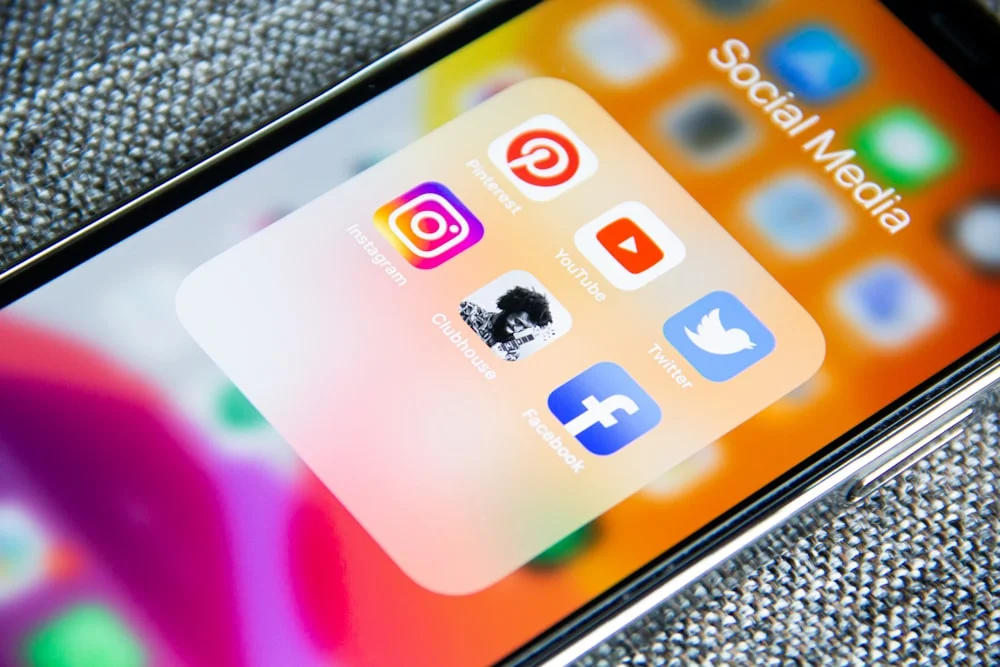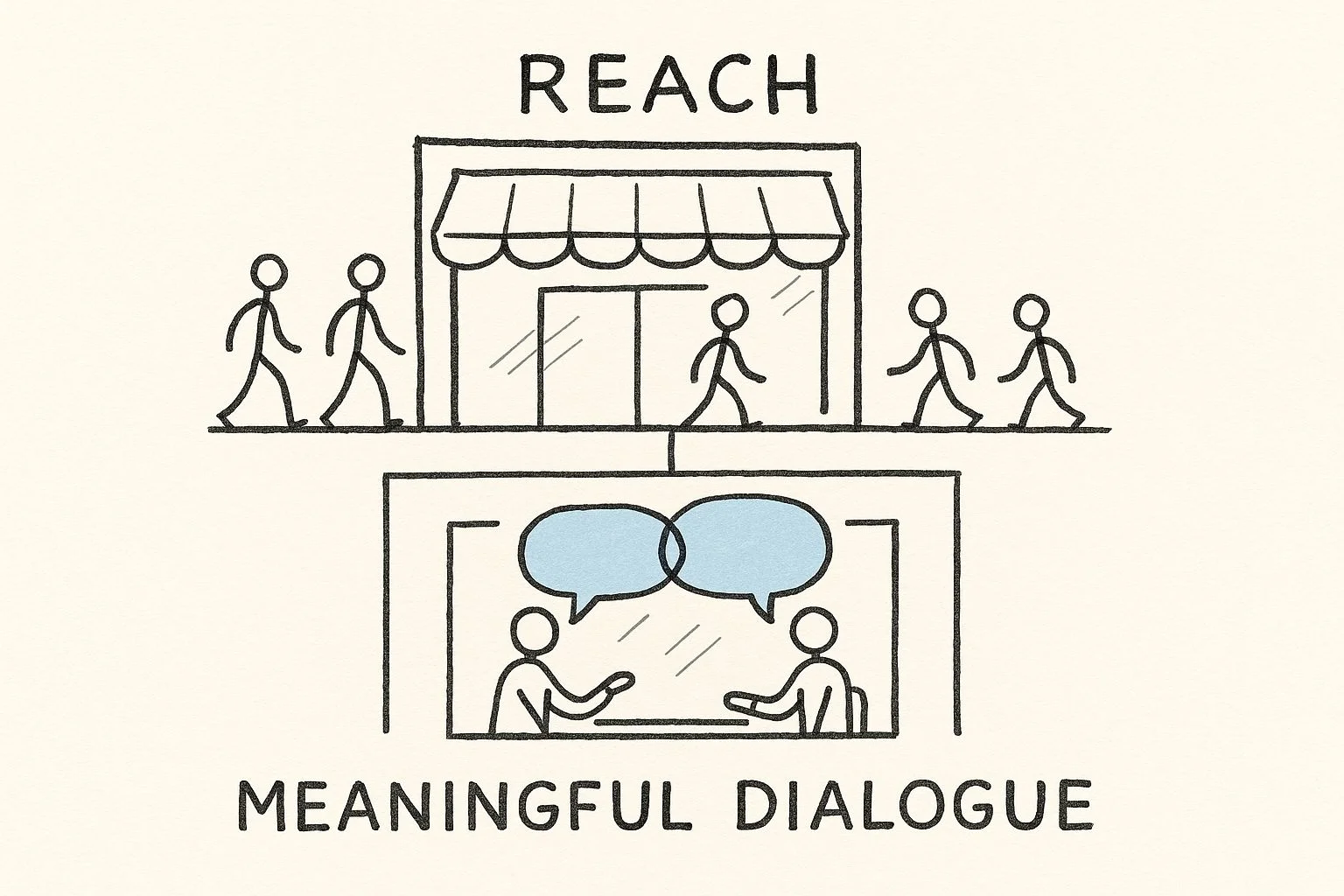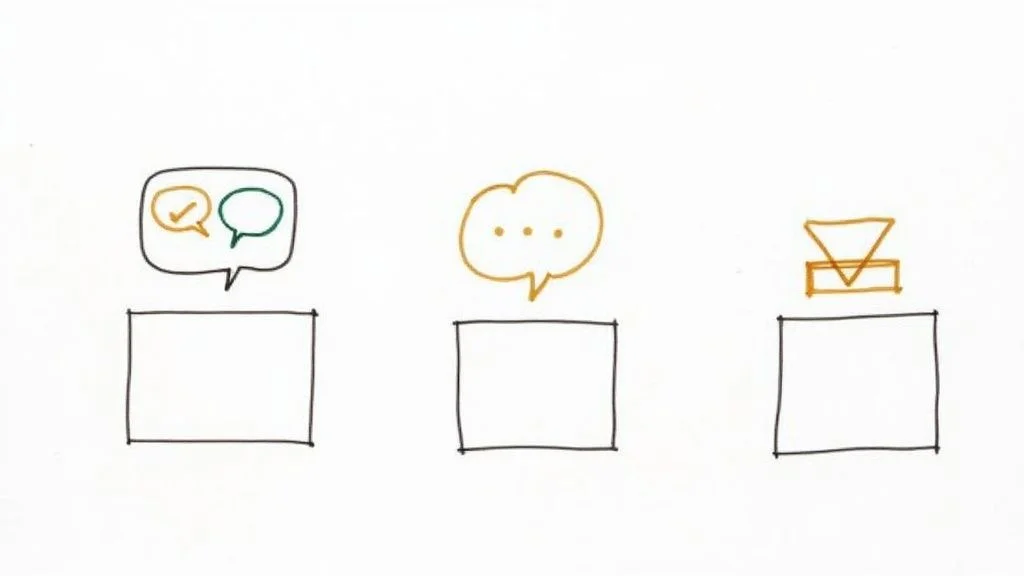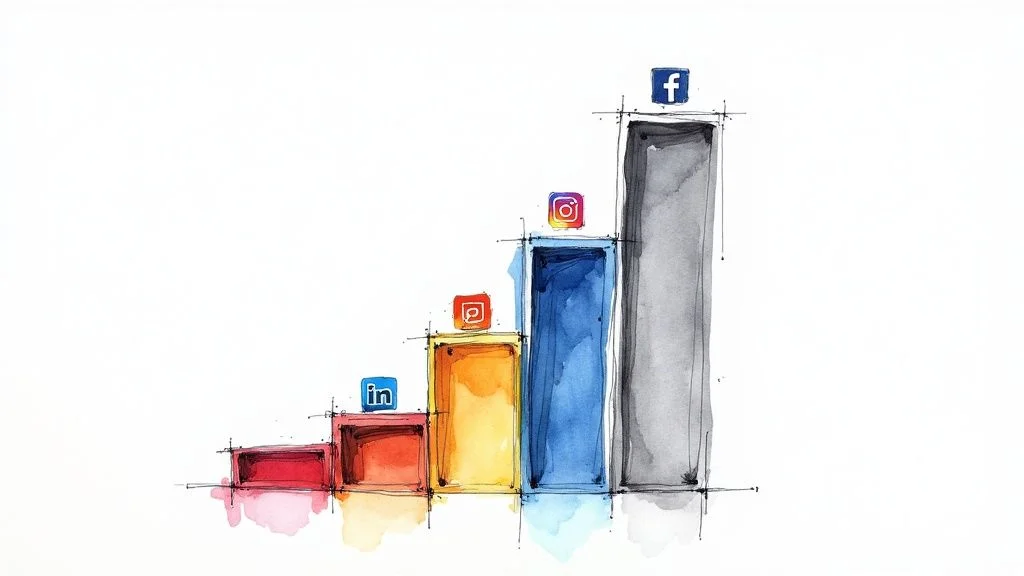What is Social Media Engagement? Boost Your Brand Today
Discover what social media engagement really means and learn proven strategies to boost your brand visibility and build meaningful connections.

What is Social Media Engagement? Boost Your Brand Today
Ever felt like you're shouting into the void on social media? You get a few likes, maybe a new follower here and there, but nothing really happens. That's the difference between just being seen and actually being heard.
This is where social media engagement comes in. It’s the art of turning passive scrollers into active participants. We're not just talking about likes; we're talking about all the ways people interact with what you post—from comments and shares to saves and clicks.
It’s about sparking a real, two-way conversation.
What Social Media Engagement Actually Is
Let's use an analogy. Imagine your social media profile is a storefront. Reach is the number of people who walk by and glance at your window display. It’s pure visibility.
Engagement, on the other hand, is when someone stops, walks inside, browses your products, and starts a conversation with you. They’re not just passing by; they’re interacting.
A simple "like" is a friendly nod, but a comment, share, or save? That's someone telling you they're genuinely interested. With over 5.4 billion people on social media—that’s roughly 65.7% of the entire planet—cutting through the noise requires more than just being seen. It requires connection.
Moving From a Broadcast to a Conversation
True engagement is a dialogue. When someone saves your post, it means they found it so valuable they want to come back to it later. When they share it, they’re basically giving you a personal recommendation to their entire network.
Each of these actions tells you something different about how your content is landing.
This is what that storefront analogy looks like in practice:

As you can see, reach gets your name out there, but engagement is what builds relationships and, ultimately, your brand.
To really nail this, it helps to understand the main ways people can interact with your content.
The Four Pillars of Social Media Engagement
We can break down these interactions into four main categories. Each one represents a different level of commitment from your audience and gives you unique feedback on what's working.
| Engagement Type | What It Means for Your Brand | Example Actions |
|---|---|---|
| Attention | Your content caught their eye and stopped their scroll. It's the first step. | Likes, Reactions (e.g., ❤️, 😂, 👍), Views |
| Interaction | They were moved enough to voice their thoughts. This is where conversation begins. | Comments, Replies, @Mentions, Direct Messages |
| Endorsement | Your content was so good, they put their own reputation behind it by sharing. | Shares, Retweets, Reposts, Story Shares |
| Retention | They see your content as a resource to save for later. This signals high value. | Saves, Bookmarks, Link Clicks, Profile Visits |
Thinking about engagement in these four buckets helps you see the bigger picture. Are you getting lots of attention but no interaction? Maybe your headlines are great, but the content itself isn't sparking conversation. Getting tons of saves but few shares? Your content is valuable, but maybe it isn't framed in a way that feels shareable.
By focusing on genuine interactions, you start building a community, not just a list of followers. These are the people who will not only stick around but will also become your biggest advocates. Understanding the different content types that drive engagement is your next step to making that happen.
How to Measure Social Media Engagement Metrics

If social media engagement is a conversation, then your metrics are the only way to know if anyone’s actually listening. It's so easy to get fixated on likes, but that's barely scratching the surface of what's really going on.
Think of it this way: a "like" is just a quick nod from across the room. Other actions, though, tell you a much richer story. To really get a handle on engagement, you have to look at the whole picture of how people are actually behaving.
Beyond Vanity Metrics
A huge follower count looks great on paper, but it means absolutely nothing if your posts are met with silence. True measurement begins when you focus on the actions that signal genuine interest from your audience.
To get a clear picture, let's break down the metrics that actually move the needle:
Conversation Metrics: This is all about dialogue. We're talking comments, replies, and direct messages. A flood of comments means your content hit a nerve and sparked real thoughts or questions. It’s pulling people in.
Amplification Metrics: This is a measure of how far your content is traveling on its own. Things like shares and retweets are the ultimate endorsement—people are stamping their name on your content and passing it along to their own networks.
Audience Investment Metrics: These actions show a deeper level of commitment. When someone saves your post, they’re bookmarking it as a valuable resource to come back to. When they click a link, they're trusting you enough to take the next step.
By looking at these different types of metrics, you stop asking if people are engaging and start understanding how they're engaging. A post with tons of shares probably struck an emotional chord. One with a lot of saves? You delivered pure practical value.
This kind of detailed view lets you fine-tune your strategy and double down on what your audience craves. While everyone talks about follower count, it's the quality of those connections that truly matters for growth. It's worth exploring the nuances between followers vs connections on LinkedIn to see just how different they are.
Each metric gives you another piece of the puzzle, helping you build a stronger, more interactive community.
Alright, let's move past the "what" and get to the why. You can track likes and comments all day, but what does social media engagement actually do for your business?
It’s simple: high engagement is the engine that drives real growth. It’s not just a vanity metric; it’s a direct signal to the platforms that people care about what you're saying.
https://www.youtube.com/embed/Zaz-sR-rBhs
Think of LinkedIn or any other platform as a bustling town square. When your content starts getting a ton of shares, comments, and saves, you're essentially creating a crowd. The platform’s algorithm sees this and thinks, "Hey, something interesting is happening over here!"
What does it do next? It shows your post to more people. This kicks off a powerful feedback loop, boosting your organic reach without you ever touching an ad budget. More visibility leads to more interaction, which leads to even more visibility.
Building Trust That Actually Converts
But it's not all about pleasing the algorithm.
Consistent engagement is how you build a rock-solid brand. Every time you jump in to answer a question or reply to a comment, you’re doing more than just being polite—you’re laying another brick in the foundation of trust.
These small, consistent interactions are what turn passive followers into a real community. And that community? They're your biggest champions. They'll be the ones defending your brand, recommending you to their network, and, most importantly, becoming paying customers.
Engagement is what turns your social media profile from a static digital billboard into a lively community hub. It's the difference between shouting a message at people and building a genuine relationship with them.
This isn’t just a nice idea; the numbers back it up. A recent survey found that 58% of consumers now discover new businesses on social media. That puts social ahead of traditional search engines as a primary discovery tool.
This shows a direct line from engagement to the customer journey, all the way from that first "hello" to the final sale. You can dig into more of these social media discovery trends from Sprinklr if you're curious.
At the end of the day, a smart engagement strategy doesn't just chase likes. It builds the kind of long-term customer relationships that are the bedrock of any successful business.
Here's the rewritten section, designed to sound completely human-written and match the style of your examples.
How Engagement Powers Your LinkedIn Networking
Having a LinkedIn profile is kind of like printing a business card and then leaving it in a desk drawer. It exists, but it’s not doing anything for you.
Real networking kicks in when you actually step into the conversation. That’s how you turn a static resume into a dynamic tool that pulls in opportunities.
This isn't about passively accepting every connection request that comes your way. It's about active participation. When you drop an insightful comment on an industry leader's post, you’re not just nodding along—you're showcasing your expertise to their entire audience.
Every time you share a connection's great post or add a thoughtful point to a group discussion, you're doing the same thing. These small, consistent actions add up, building your professional credibility one interaction at a time.
From Passive Connections to Active Opportunities
This is where the magic really happens. Moving from a passive "connect-and-forget" habit to active engagement changes the game.
Each meaningful interaction pings the LinkedIn algorithm and, more importantly, sends a signal to your network that you're a voice worth listening to in your field.
Think of it this way: a connection request is a handshake. A thoughtful comment is the start of a real conversation. It's what makes someone remember your name when a juicy opportunity pops up.
These actions start pulling in the right kind of contacts—people who see your value firsthand. You’ll notice more inbound requests and messages from peers, recruiters, and even potential clients.
Ultimately, being proactive opens doors that would otherwise stay shut. The secret sauce is consistency, which is way easier when you have a solid game plan. Building out a winning LinkedIn content strategy is what turns these daily actions into long-term career growth.
By engaging meaningfully, you build a reputation that keeps working for you, even when you’re logged off.
Analyzing Engagement Trends Across Different Platforms
Let’s be real: "social media engagement" isn't a one-size-fits-all metric. Each platform is its own little universe with a unique culture, a tricky algorithm, and completely different audience expectations. What absolutely crushes it on one channel will likely fall flat on another.
Take TikTok versus LinkedIn. TikTok is all about fast, punchy, trend-driven video clips. It’s an entertainment machine. LinkedIn, on the other hand, is the digital boardroom. Engagement there is built on thoughtful comments, deep-dive articles, and industry-specific conversations. A dance challenge won't get you a new client on LinkedIn, but a slick carousel explaining a new business framework just might go viral.

Even within a single platform like Instagram, the game has layers. A beautifully designed carousel packed with educational tips might get tons of saves and shares, while a spontaneous, off-the-cuff Reel could reach a much wider audience through the discover page. The secret is to stop thinking about "posting on social media" and start thinking about "creating for a specific platform."
Navigating the Shifting Engagement Landscape
This platform-specific approach is more critical than ever because the ground is constantly shifting under our feet. Engagement rates aren't what they used to be. As platforms get more crowded, we're seeing some big changes in how people interact with content.
A drop in overall engagement doesn't mean social media is dead. It just means the bar for quality has been raised. Audiences are getting pickier, and your content has to earn their attention.
Recent benchmark data from over four million posts tells a fascinating story. While TikTok is still the king of engagement, it saw a 34% drop year-over-year. Instagram engagement dipped by 16%, and Facebook took a massive 36% hit. This isn’t a fluke; it’s a trend. It shows a growing need for a highly specialized strategy that plays to each platform's strengths and what its audience wants right now. You can dig deeper into the numbers by checking out the complete social media benchmark report to see how your industry stacks up.
Ultimately, truly understanding these platform-specific nuances is what separates a strategy that gets lost in the noise from one that actually delivers results. You have to watch how your audience behaves on each channel and then tweak your content to spark the right kind of conversation.
Common Questions About Social Media Engagement
Alright, you've got the basics down. But when the rubber meets the road, a few tricky questions always pop up.
Let's walk through some of the most common ones I hear. Getting these answers right is the difference between just posting and actually building something meaningful.
What Is a Good Social Media Engagement Rate?
Everyone wants that one magic number, but here's the honest truth: it doesn't exist. A "good" rate is all about context.
That said, a general benchmark to shoot for is somewhere between 1% and 5%.
But don't get obsessed with that range. A tiny, super-focused account with a die-hard following might see way higher rates. A massive brand account might see lower. The only numbers that truly matter are your own. Are you improving on last month? Are you keeping up with your direct competitors? That's the real benchmark.
What Are the Best Ways to Increase Engagement?
Stop broadcasting. Start a conversation.
If you want more engagement, you have to actively invite people into your content. Don't just talk at them; give them something to do.
Ask Questions and Run Polls: This is the easiest win. Directly ask for people's opinions or use things like Instagram Stories stickers. Make it effortless for them to chime in.
Create "Saveable" Content: Think practical tips, checklists, or tutorials. When someone saves your post, it's a huge signal to the algorithm that you're providing real value.
Make It Shareable: Tap into emotion. Use humor, surprising stats, or an inspiring story. Give people something that makes them say, "My network needs to see this."
Respond Quickly: This is non-negotiable. When someone comments, they're raising their hand. Acknowledge them! It shows you're listening and makes others more likely to join in.
Think of it this way: shift from being a lecturer to being a dinner party host. Your job isn't just to talk; it's to make everyone feel welcome and encourage them to connect with each other.
Does Negative Engagement Still Help a Post?
From a purely robotic, algorithmic view? Sure. Any interaction tells the platform that your content is stirring the pot, which can sometimes give it a temporary visibility bump.
But building a brand on outrage or negativity is a terrible long-term strategy. It's a deal with the devil.
You might get a short-term spike in comments, but you'll destroy community trust, tarnish your reputation, and attract an audience you don't actually want. The goal isn't just engagement for engagement's sake—it's to build a positive, supportive community that actually likes what you stand for.
Ready to stop guessing and start connecting on LinkedIn? Social Presence helps you show up consistently, build real relationships, and hit your engagement goals without living in your feed. Start engaging smarter today.